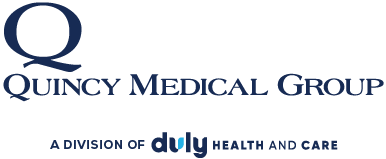About 1 in 8 women in the United States will develop breast cancer over the course of her lifetime. October is recognized as Breast Cancer Awareness Month and serves as an opportunity for women to get informed.
Quincy Medical Group Oncologist Christian Khoury, M.D. said that with the frequency of the disease in the United States, it’s important for women to be aware of their screening options and risk factors. “Women need to be aware because it is the most frequent cancer in women (excluding skin cancer) and the second most frequent cause of death from cancer (after lung cancer).”

Prevention measures, he said, vary depending on the individual. Health professionals agree mammograms should be done at age 50, once a year for screening. However, this recommendation could change based on a woman’s individual needs and situation, and mammograms are commonly started at the age of 40. “It’s hard to give recommendations for just the average woman because no person is average,” explained Dr. El-Khoury. “They should discuss their health with their doctor because some have more risk of breast cancer than others. For some, depending on their history, more may need to be done.”
It’s important for women to be aware of potential risk factors for the disease. One of these risk factors is family history of breast cancer and other cancers. “Family history matters, especially when you have first-degree relatives involved such as a mother, sister, or rarely a father. Second-degree relatives matter too, but to a lesser degree. There are ways to estimate cancer risk based on family history, but they are not always 100% reliable. Women should nevertheless be aware of their family history, and some of them will benefit from gene testing.”
Beyond family history, Dr. Khoury said, women should be aware of their body and any changes that occur. “Women need to be aware of changes affecting their breasts, and actually many women are not. They may not self-examine, or they may see or feel something and ignore it. Some of them are too scared to make a move, so they do nothing. They should know there are always options available, treatment is often manageable and they should not just wait on it.”
Other modifiable risk factors include obesity, excessive alcohol use, and some birth control pills. Dr. Khoury said after taking all the risk factors into consideration, physicians try to estimate the patient’s risk of the disease. Depending on the risk, other measures can be taken. This could include an MRI in addition to a mammogram. Other options could be preventive hormonal therapy, where patients are given medication that is designed to block or decrease estrogen, as in women with a 70% above average risk.
“It’s not chemotherapy. It’s a hormone pill that can alter the hormonal balance and prevent too much estrogen exposure to the breast. It’s something many have not heard of. It’s not new actually, studies that address this are older than ten years,” he explained.
Ultimately, Dr. Khoury said awareness of risks and taking a proactive approach to health are important. “Take into consideration risk factors and family history, then based on that determine a screening or preventive strategy with your doctor.”
